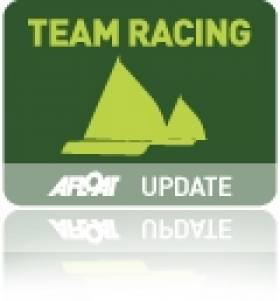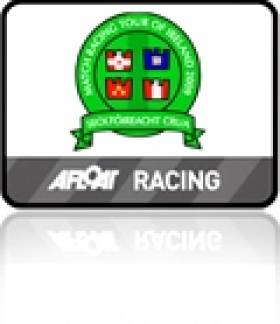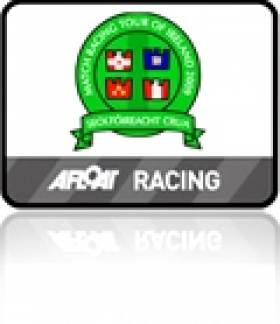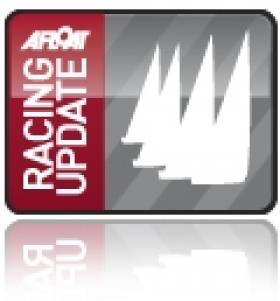Displaying items by tag: match
#colourmatch – This Saturday, Trinity Sailing Club hosts its Colours team racing Event at a new Grand Canal Dock venue in Dublin city. All six UCD and TCD teams will compete against each other in the Dubarry of Ireland sponsored event. A flyer on the event is downloadable below. Read our Colours Match event report and photography HERE.
Traditionally this event takes place in Dun Laoghaire harbour but after the success of last year's match, which took place on the River Liffey in front of the Convention Centre, Trinity is taking the event to another new and unique location – Grand Canal Dock. Racing begins at 10a.m. sharp with a head to head, best of three matches between the corresponding teams, starting with TCD6 vs. UCD6.
In the afternoon the traditional Alumni and Ladies' races will take place before the two First teams compete for the title of winners of Colour's 2015.
All are welcome to come down and watch some competitive racing this Saturday.
Eight Teams Advance to Nations Cup Semifinals
Friday's conditions—a light southeasterly breeze that forced race officials to delay the first start until about 1 p.m.—were a marked change from the previous two days of racing that featured moderate to heavy winds and choppy seas.
In the open division, the semifinal berth came down to the wire in a race between Haddad (crew Mario Trindade, Victor Demaison) and Shawn Bennett (USA) who went into the final match tied with two wins each. Przemek Tarnacki (POL) finished with one win and Peter Wickwire (CAN) was winless in the round.
Goncalves (crew Mariana Lobato, Diane Neves) went 3-0 in the women's division repechage round robin. Genny Tulloch (USA) won two races, Juliana Senfft (BRA) won one race and Ru Wang (CHN) was winless in the round.
Following the repechage, sail-offs to determine placing from fifth down were held, and the most exciting race of the day was held during this round when Bennett and Tarnacki battled it out. Bennett drew a foul in the prestart and managed to pass Tarnacki going upwind. At the top mark, the teams went into a dial-up that carried them well past the mark. Bennett was able to break free and lead for the rest of the race, but still had to complete his penalty turn. His team was managed to get the turn in right at the line and cross just feet in front of Tarnacki for the win.
Jason Bemis, President of Sail Sheboygan, which is hosting the event at its facility optimized for match racing, said the competition has been even better than anticipated.
"We've had spectacular weather all week that has made for some great competition," Bemis said. "Today we had a little bit of a slow start but the breeze finally switched to the southeast and built for some great afternoon racing. Tomorrow's forecast looks good and we expect a large spectator fleet to be on hand for some fierce competition in the semifinals and finals."
Placements for those not moving onto the semifinals are:
Open Division (sailed in Sonars):
5th Shawn Bennett (USA, crew Dave Perry, Craig Healey)
6th Przemek Tarnacki (POL, crew Lukasz Wosinski, Maciej Zieminski)
7th Stratis Andreadis (GRE, crew Stelios Sotiriou, Theodoros Polychrondis
8th Peter Wickwire (CAN, crew Tim Bishop, Matt Christie)
9th Yasar Celal Tumse (TUR, crew Canberk Karahan, Berk Can Biren)
Women's Division (sailed in Elliott 6m's):
5th Genny Tulloch (USA, crew Alice Manard, Jenn Chamberlin)
6th Juliana Senftt (BRA, crew Gabriela Sa, Luciana Kopschitz)
7th Ru Wang (CHN, crew Pan Ting Ting, Li Xiao Ni)
8th Sharon Ferris-Choat (CAN crew Caroline Kaars Sijpesteijn, Joanne Prokop)
9th Katarzyna Pic (POL Antonina Zoltowska, Monika Kordek)
10th Dominique Provoyeur (RSA Penny Alison, Caitlin Moore)
Racing continues Saturday with the start of the semifinal round.
World's Top Match Racers Compete in Nations Cup Final
Hosted by Sail Sheboygan, the competition will see some of the finest sailors from across the globe mixing it up along the Lake Michigan shore in identical one-design class sailboats for this culmination of a series of eight match racing regattas that started in Porto Alegre, Brazil, on 24 March.
The ISAF Nations Cup is a global competition to find the world's top match racing nation in open and women's events, while also promoting and developing the sport of match racing in sailing, which pits one boat against another. Gaining popularity, women's match racing will make its debut as an Olympic Sailing event for the 2012 Olympic Games in London. The 2011 Nations Cup included seven regional finals, from which the top teams will compete in Sheboygan. The Grand Final will be sailed in the Sonar class for the open event and the Elliott 6m for the women's event.
Ten teams will compete in the women's event, and ten entries have been confirmed in the open event. In the women's event, two-time defending champion and number one ISAF ranked women's match racing skipper and #4 in the world, Claire Leroy (FRA) and her crew will go up against the American team led by Genny Tulloch, ranked #11, and Olympic medallist Mandy Mulder of the Netherlands, ranked #17. Further competition is expected from the Brazilian team led by Nations Cup veteran Juliana Senfft.
The open event will see American Shawn Bennett and his crew of Dave Perry and Craig Healy take on the Danish team led by Mads Ebler, ranked #8 in the ISAF open match racing division rankings, and New Zealand match racing winner Laurie Jury and his team. Racing for Poland will be three-time Polish match racing champion Przemek Tarnacki. Teams representing Australia, Great Britain, South Africa, France, China, Pakistan, Greece, Turkey and Canada will also be sailing for the cup.
Antonio González De Le Madrid, ISAF Competitions Manager, said, "We are delighted that some of the world's best match racers will be making the trip to Sheboygan for the ISAF Nations Cup. There are some very experienced sailors lining up alongside those who are in the early stages of their development. Nonetheless it should make for a fantastic few days of match racing action."
According to Sail Sheboygan's, Executive Director, Rich Reichelsdorfer, said, "Sail Sheboygan is excited and honored to be hosting the Grand Final of the Nations Cup. We have assembled a top-class race management team backed up by a dedicated corps of volunteers for this premiere match-racing event and we can't wait to show the world our facility. With dozens of the best match-racing sailors in the world coming to Sheboygan, the ISAF Nations Cup will be a spectacle to be enjoyed both by sailors and spectators alike. The racing is sure to be fast and furious and the onshore activities will be equally fun."
A non-profit organization, Sail Sheboygan, was formed in 2004 to promote national and international sailing competition and education. As one of only four US Sailing Centers, its mission is to develop sailing and seamanship at all levels, regardless of age, income, ability or disability.
Team Echo Win Dublin Match Race Event
After a three round robin series organised by Howth Yacht Club, visting Team Echo, from Poole in Dorest, won Dublin's 2011 Match Racing Open. The team made up of Mark Lees, Toby Yeabsley, Mark Yeabsley and Peter Austin convincingly won the Investwise sponsored series, sailed in J80s with 11 wins and one loss.
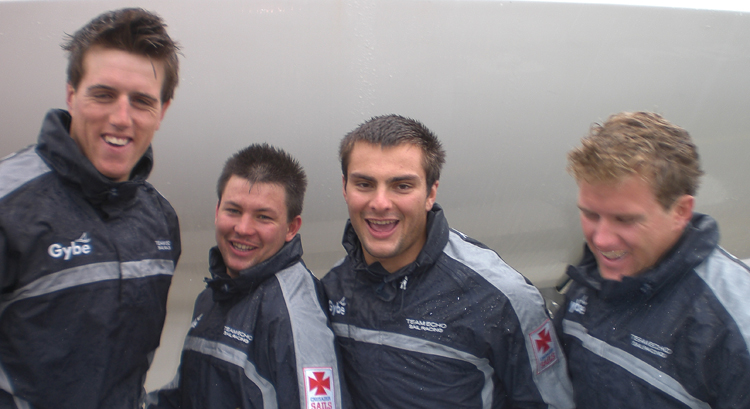
Team Echo won the Dublin Match Racing Open
In the second race an unfortunate incident where bowman Peter Austin cut his leg disrupted the usual momentum of the team. an Irish Match racer kindly stepped in as a substitute for the remainder of racing one the first day and regular mainsheet trimmer Toby Yeabsley stepped in as bowman while Peter went to be treated in hospital.
A tie break was required to split the home clubs team - consisting of evelopment squad members skippered by Ryan Scott - from Peter Bayly and Team PN, with the HYC Development Squad taking second 2 wins to 1. Peter showed glimpses of what he can do, the only skipper to take a race form the British team.
Alistair Kissane and Team Pies finished fourth and Audrey Adamson with SailingWest Ladies finished fifth.

Racing Round Up - Weekend Irish Sailing Review
Ireland Fails to Conquer the World at Match Racing Challenge
A very experienced International line up, led by individual winner David Chapman (AUS), resulted in The World retaining the title they won last year. While the margin of victory was great, they were strongly pushed by a young Irish team who on paper were ranked far lower in the World Rankings. The final margin of victory was 29 points to 16.
An exciting part of the event's entertainment package allowed individuals to actually experience the racing as it happened by sailing on board with a team in the "Hot Seat" position. Edel Edwards, who lives in Dublin, had never sailed before but stepped into the "Hot Seat" on Saturday not knowing what to expect. She sailed with both George Kingston's team (IRL) in Flight 7 and Sam Pearson (GBR) in Flight 8, and said that the experience surpassed her expectations, "Both teams were really welcoming and being so close to the action was fantastic. It was one of the most amazing experiences of my life." Edel loved it so much she has decided to do an adult sailing course in the Royal St. George Yacht Club so that she can get out racing again soon.
Final Results:
1st David Chapman Australia World No. 43
2nd Sam Pearson Great Britain World No. 153
3rd Nicolai Sehested Denmark World No. 42
4th George Kingston Ireland World No. 877
5th Marty O'Leary Ireland World No. 395
6th Robbie Allam Great Britain World No. 79
7th Ben Duncan New Zealand World No. 200
8th Darragh O'Connor Ireland World No. 1323
9th Ben Scallan Ireland World No. 1674
10th John Downey Ireland Unranked



























